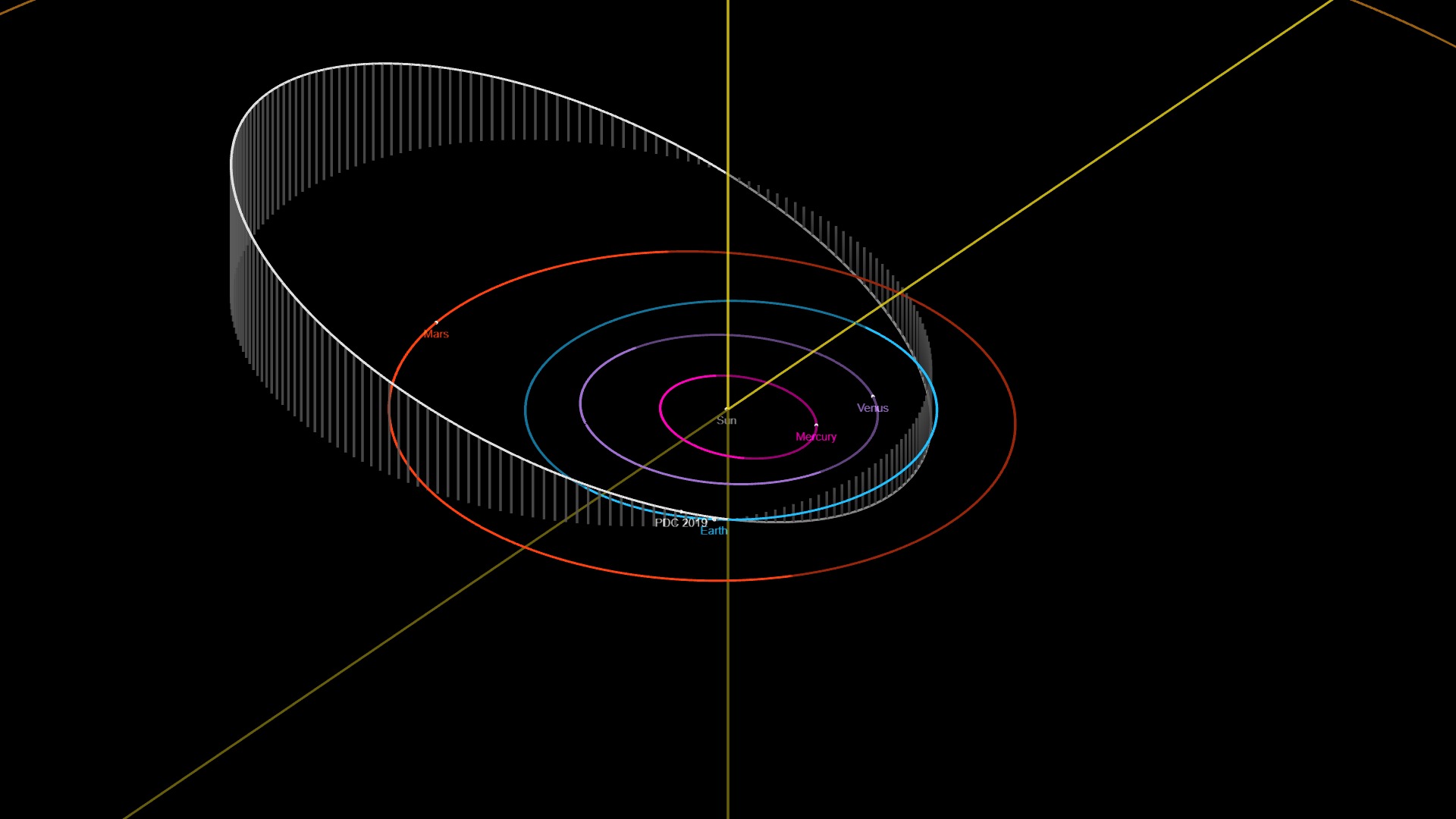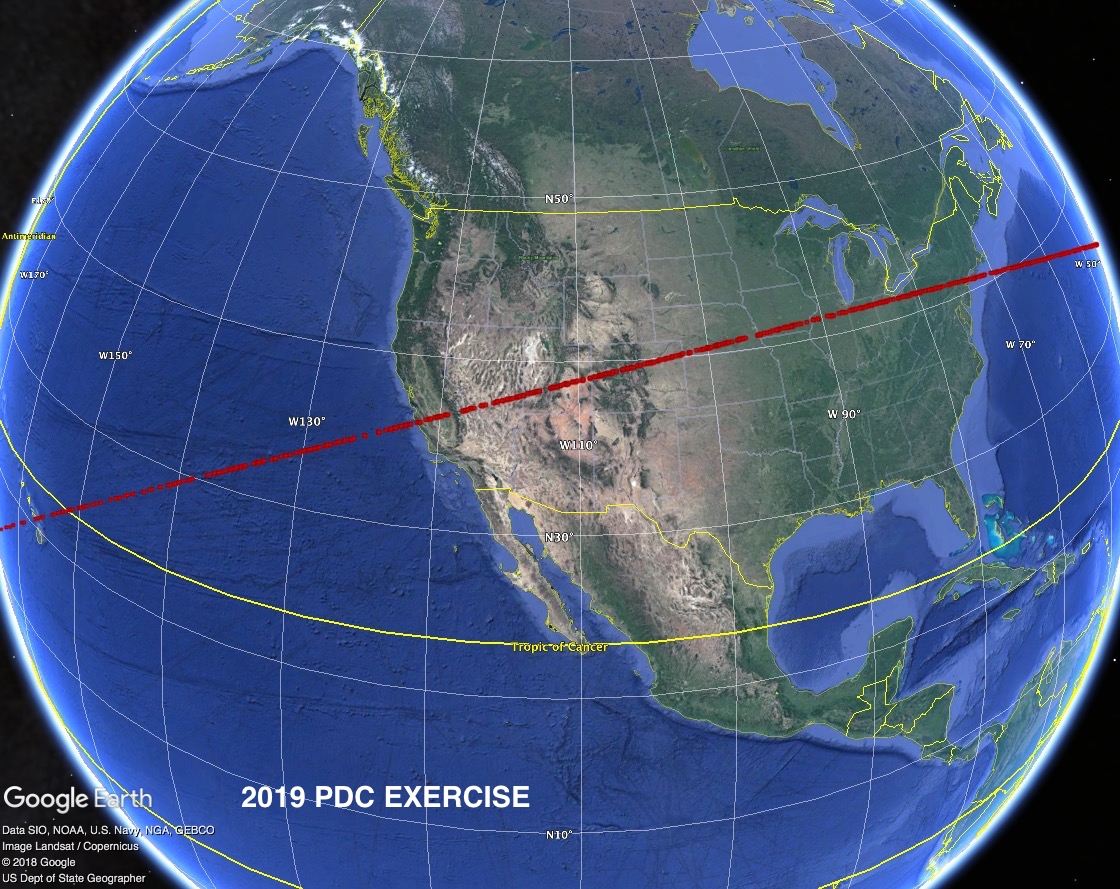Setting the scene: Planetary Defense Conference 2019
Every two years, asteroid experts from across the globe come together to pretend an asteroid impact is imminent. During these week-long impact scenarios, participants don’t know how the situation will evolve know from one day to the next but must make plans based on the daily updates they are given.
For the first time, ESA will be live tweeting the hypothetical impact scenario from the heart of the Planetary Defense Conference (PDC) in Washington DC – so you’ll find out the ‘news’ as the experts do. What will they do? What would you do?
“The first step in protecting our planet is knowing what’s out there”, says Rüdiger Jehn, ESA’s Head of Planetary Defence.
“Only then, with enough warning, can we take the steps needed to prevent an asteroid strike altogether, or minimise the damage it does on the ground”.
This year’s asteroid – 2019 PDC
The scene has been set for this year’s hypothetical impact scenario. Although realistic, is it is completely fictional and does NOT describe an actual asteroid impact.
— An asteroid was discovered on 26 March, 2019, and has been given the name “2019 PDC” by the Minor Planet Center.
— Initial calculations suggest the orbit of 2019 PDC will bring it within 7.5 million km of Earth’s orbit. (Or, within 0.05 AU of Earth’s orbit. One AU is the mean distance between the Sun and Earth, equal to 149 597 870.7 km). — 2019 PDC is travelling in an eccentric orbit, extending 2.94 AU at its farthest point from the Sun (in the middle of the main asteroid belt), and 0.94 AU at its closest. It completes one full orbit around the Sun every 971 days (2.66 years). See its orbit in more detail, here: https://go.nasa.gov/2vkZyT5
— 2019 PDC is travelling in an eccentric orbit, extending 2.94 AU at its farthest point from the Sun (in the middle of the main asteroid belt), and 0.94 AU at its closest. It completes one full orbit around the Sun every 971 days (2.66 years). See its orbit in more detail, here: https://go.nasa.gov/2vkZyT5
— The day after 2019 PDC is discovered, ESA and NASA’s impact monitoring systems identify several future dates when the asteroid could hit Earth. Both systems agree that the asteroid is most likely to strike on 29 April 2027 – more than eight years away – with a very low probability of impact of about 1 in 50 000.
— When it was first detected, asteroid 2019 PDC was about 57 million km from Earth, equal to 0.38 Astronomical Units. It was travelling about 14 km/s, and slowly getting brighter.
— As observations continue, the likelihood of an impact in 2027 increases. Three weeks after discovery, after observations were paused during the full Moon (and reduced visibility), the chance of impact has risen to 0.4 percent – a chance of 1 in 250. — Very little is known about the asteroid’s physical properties. From its brightness, experts determine that the asteroid’s mean size could be anywhere from 100-300 meters.
— Very little is known about the asteroid’s physical properties. From its brightness, experts determine that the asteroid’s mean size could be anywhere from 100-300 meters.
— Asteroid #2019PDC continued to approach Earth for more than a month after discovery, reaching its closest point on 13 May. Unfortunately, the asteroid was too far away to be detected, and it is not expected to pass close to Earth until 2027 – the year of impact.
— As astronomers continued to track #2019PDC, the chance of impact continued to rise. By April 2019, the first day of the Planetary Defence Conference, the probability of impact rises to 1%.
Follow @esaoperations on Twitter for live coverage of the conference, and find daily updates on the asteroid impact scenario here, beginning on Monday 29 April.
from Rocket Science http://bit.ly/2PwRcRO
v
Setting the scene: Planetary Defense Conference 2019
Every two years, asteroid experts from across the globe come together to pretend an asteroid impact is imminent. During these week-long impact scenarios, participants don’t know how the situation will evolve know from one day to the next but must make plans based on the daily updates they are given.
For the first time, ESA will be live tweeting the hypothetical impact scenario from the heart of the Planetary Defense Conference (PDC) in Washington DC – so you’ll find out the ‘news’ as the experts do. What will they do? What would you do?
“The first step in protecting our planet is knowing what’s out there”, says Rüdiger Jehn, ESA’s Head of Planetary Defence.
“Only then, with enough warning, can we take the steps needed to prevent an asteroid strike altogether, or minimise the damage it does on the ground”.
This year’s asteroid – 2019 PDC
The scene has been set for this year’s hypothetical impact scenario. Although realistic, is it is completely fictional and does NOT describe an actual asteroid impact.
— An asteroid was discovered on 26 March, 2019, and has been given the name “2019 PDC” by the Minor Planet Center.
— Initial calculations suggest the orbit of 2019 PDC will bring it within 7.5 million km of Earth’s orbit. (Or, within 0.05 AU of Earth’s orbit. One AU is the mean distance between the Sun and Earth, equal to 149 597 870.7 km). — 2019 PDC is travelling in an eccentric orbit, extending 2.94 AU at its farthest point from the Sun (in the middle of the main asteroid belt), and 0.94 AU at its closest. It completes one full orbit around the Sun every 971 days (2.66 years). See its orbit in more detail, here: https://go.nasa.gov/2vkZyT5
— 2019 PDC is travelling in an eccentric orbit, extending 2.94 AU at its farthest point from the Sun (in the middle of the main asteroid belt), and 0.94 AU at its closest. It completes one full orbit around the Sun every 971 days (2.66 years). See its orbit in more detail, here: https://go.nasa.gov/2vkZyT5
— The day after 2019 PDC is discovered, ESA and NASA’s impact monitoring systems identify several future dates when the asteroid could hit Earth. Both systems agree that the asteroid is most likely to strike on 29 April 2027 – more than eight years away – with a very low probability of impact of about 1 in 50 000.
— When it was first detected, asteroid 2019 PDC was about 57 million km from Earth, equal to 0.38 Astronomical Units. It was travelling about 14 km/s, and slowly getting brighter.
— As observations continue, the likelihood of an impact in 2027 increases. Three weeks after discovery, after observations were paused during the full Moon (and reduced visibility), the chance of impact has risen to 0.4 percent – a chance of 1 in 250. — Very little is known about the asteroid’s physical properties. From its brightness, experts determine that the asteroid’s mean size could be anywhere from 100-300 meters.
— Very little is known about the asteroid’s physical properties. From its brightness, experts determine that the asteroid’s mean size could be anywhere from 100-300 meters.
— Asteroid #2019PDC continued to approach Earth for more than a month after discovery, reaching its closest point on 13 May. Unfortunately, the asteroid was too far away to be detected, and it is not expected to pass close to Earth until 2027 – the year of impact.
— As astronomers continued to track #2019PDC, the chance of impact continued to rise. By April 2019, the first day of the Planetary Defence Conference, the probability of impact rises to 1%.
Follow @esaoperations on Twitter for live coverage of the conference, and find daily updates on the asteroid impact scenario here, beginning on Monday 29 April.
from Rocket Science http://bit.ly/2PwRcRO
v

Aucun commentaire:
Enregistrer un commentaire